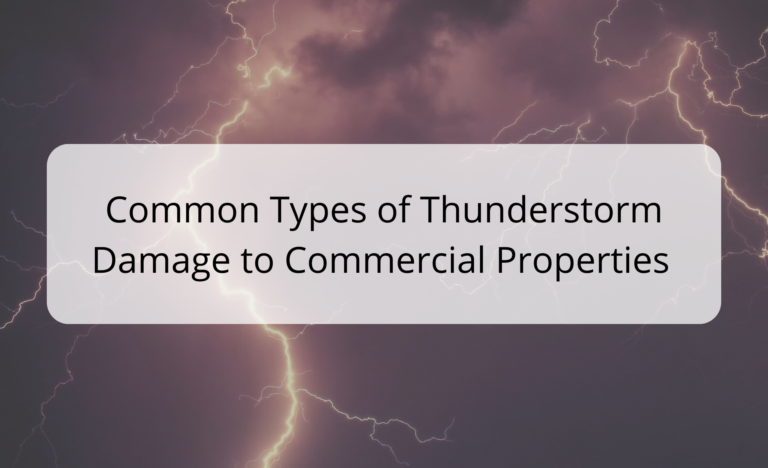When dark clouds gather, and thunder rumbles on the horizon, the potential for thunderstorm damage to commercial properties looms large. Thunderstorms can unleash a fury of destructive elements, from powerful winds and torrential rains to lightning strikes and hail. For business owners and property managers, understanding the various types of damage that can occur is crucial for preparedness and effective recovery. In this comprehensive guide, we explore the common types of thunderstorm damage that can impact commercial properties and how to navigate the aftermath.
Common Types of Thunderstorm Damage
- Roof Damage
Commercial property roofs bear the brunt of a thunderstorm’s assault. High winds can loosen or tear roofing materials, leaving vulnerabilities for water penetration. Heavy rains can exploit these weaknesses, leading to leaks and structural damage. Roofs may also suffer from hail impact, resulting in punctures, cracks, and granule loss on asphalt shingles. It’s imperative for commercial property owners to have their roofs inspected regularly to identify and address vulnerabilities before a storm strikes.
- Flooding and Water Damage
Thunderstorms can bring intense rainfall, overwhelming drainage systems and causing flooding. For commercial properties, this can mean water intrusion through windows, doors, and even foundation cracks. The aftermath of flooding includes damaged inventory, equipment, and structural components. Developing a robust flood mitigation plan that includes proper drainage systems, sump pumps, and waterproofing measures is essential for minimizing water damage risks.
- Electrical Damage
Lightning is a common occurrence during thunderstorms, and when it strikes a commercial property, it can cause extensive electrical damage. Power surges can fry electrical systems, leading to outages and the destruction of expensive equipment and machinery. Investing in lightning protection systems and surge suppressors can safeguard your property against electrical damage during storms.
- Wind Damage
The high winds associated with thunderstorms pose a significant risk to commercial properties. Wind can tear off siding, shatter windows, and even topple structures. Ensuring that windows and doors are properly reinforced and that loose objects are secured can mitigate wind-related damage. Regular inspections can also identify potential weaknesses in the building’s structure.
- Hail Damage
Hail, often a companion of thunderstorms, can wreak havoc on commercial properties. It can dent metal roofs, damage HVAC systems, and break windows. Roofing materials may experience granule loss, which can lead to further deterioration over time. A thorough inspection after a hailstorm is essential to identify and address all hail-related damage promptly.
- Tree Damage
Strong winds during thunderstorms can uproot trees or break branches, posing a significant threat to commercial properties. Trees falling onto structures can cause extensive damage and endanger occupants. Property owners should regularly trim trees near buildings and consider removing those that pose a high risk during storms.
- Inventory and Equipment Damage
For businesses with inventory or specialized equipment, thunderstorm damage can result in significant financial losses. Flooded warehouses, damaged machinery, and ruined stock can disrupt operations and strain finances. Having a comprehensive insurance policy that covers both property and business interruption is crucial for mitigating these risks.
- Fire Risk
Lightning strikes can ignite fires, posing an immediate threat to commercial properties. Fire damage can be devastating, leading to property loss, inventory destruction, and potential injury to occupants. Installing lightning protection systems and maintaining fire safety measures, such as fire alarms and sprinkler systems, is essential to reduce fire risks during thunderstorms.
Navigating the Aftermath
Recovering from thunderstorm damage to a commercial property can be a complex and time-consuming process. Property owners should take the following steps:
- Safety First: Ensure the safety of all occupants and employees. Evacuate if necessary and only return when it’s deemed safe by authorities.
- Document Damage: Thoroughly document all damage with photographs and written descriptions. This evidence is crucial when filing insurance claims.
- Contact Your Insurance Provider: Notify your insurance company promptly and provide them with all necessary documentation. Work closely with your public adjuster to ensure a fair and accurate assessment of the damage.
- Secure the Property: Take steps to prevent further damage, such as tarping damaged roofs and boarding up broken windows.
- Mitigate Mold and Water Damage: Address water damage promptly to prevent mold growth, which can be a significant health hazard and further damage your property.
- Professional Assessment: Seek professional assessments of structural damage and necessary repairs. Engage qualified contractors and restoration specialists to make the property safe and habitable.
Frequently Asked Questions
Does commercial property insurance typically cover thunderstorm damage?
Most commercial property insurance policies include coverage for thunderstorm damage, but the specific coverage can vary. It’s essential to review your policy and understand the terms, limits, and deductibles associated with thunderstorm-related claims.
What should I do if my commercial property is located in a high-risk thunderstorm area?
If your property is in an area prone to thunderstorms, invest in preventive measures such as lightning protection systems, reinforced roofing, and proper drainage systems. Regular inspections and maintenance are key to minimizing damage risks.
How can I expedite the insurance claims process after thunderstorm damage?
Promptly document all damage, contact your insurance provider immediately, and work with a public adjuster to ensure an accurate assessment of the damage. Responding swiftly can help expedite the claims process.
Can I reopen my business while repairs are ongoing?
It depends on the extent of the damage and safety considerations. In some cases, you may be able to continue operations in unaffected areas or temporarily relocate. Consult with professionals to determine the best course of action.
Navigating Thunderstorm Damage in Commercial Properties
When thunderstorms unleash their fury, the potential for damage to commercial properties becomes a stark reality. From roofing woes to water intrusion, electrical hazards, and beyond, the threats are varied and substantial. However, preparedness, prompt action, and the right insurance coverage can make all the difference in mitigating risks and expediting recovery.
How D.A. Lamont Public Adjusters Can Help
At D.A. Lamont Public Adjusters, we understand the challenges that commercial property owners face when dealing with thunderstorm damage. Our team of experienced professionals specializes in helping policyholders navigate the complex landscape of insurance claims. From assessing the extent of damage to documenting it thoroughly and negotiating on your behalf, we ensure that you receive the compensation your business needs to recover.
In times of crisis, having a knowledgeable advocate by your side can make all the difference. We’re here to guide you through the process, from the initial claim filing to the final settlement. Our goal is to minimize the stress and uncertainty that often accompany thunderstorm damage, allowing you to focus on what matters most – getting your business back on its feet.
Contact Us Today
If your commercial property has suffered thunderstorm damage, don’t hesitate to reach out to D.A. Lamont Public Adjusters. Our team is ready to assist you in every step of the claims process. Contact us today to discuss your situation, and let us help you navigate the path to recovery. Your peace of mind and your business’s future are our top priorities.


